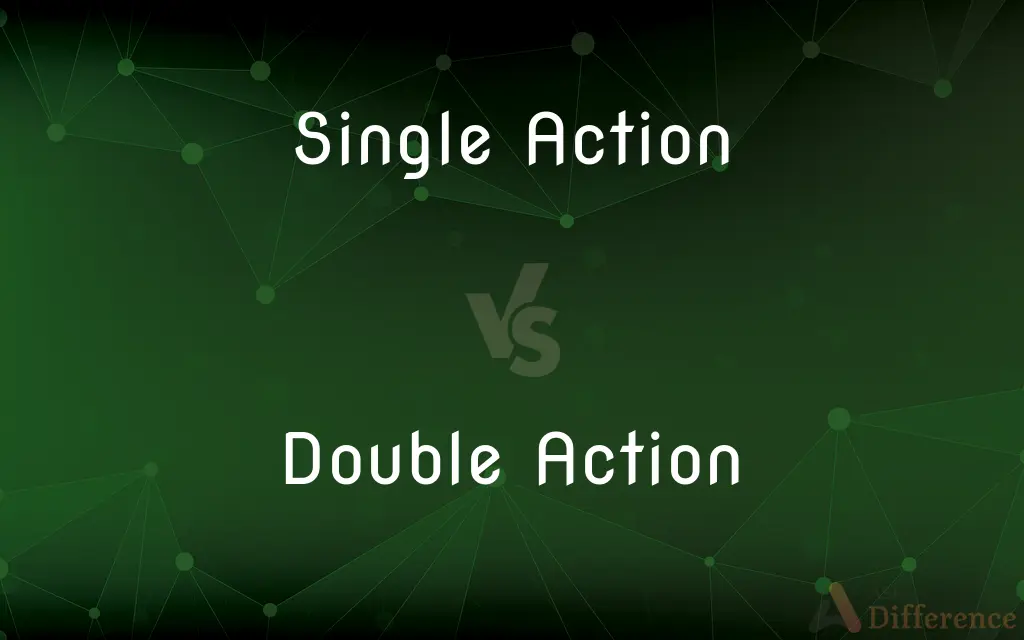Single Action vs. Double Action — What's the Difference?
Edited by Tayyaba Rehman — By Fiza Rafique — Published on November 19, 2023
In firearms, Single Action requires manual cocking; Double Action cocks and releases the hammer with one trigger pull. Both affect firing mechanisms.

Difference Between Single Action and Double Action
Table of Contents
ADVERTISEMENT
Key Differences
Single Action and Double Action are terms primarily used in firearms to describe the action of the trigger and hammer. Single Action (SA) refers to firearms where the trigger performs one action: releasing the hammer or striker. To fire again, the hammer must be manually cocked. On the other hand, Double Action (DA) refers to firearms where the trigger both cocks and releases the hammer or striker in one motion.
In Single Action firearms, once the hammer is cocked, the trigger pull is generally light and short, which can lead to more accurate shots. This is because the only function of the trigger in this mode is to release the hammer. Conversely, Double Action firearms usually have a longer and heavier trigger pull, as the trigger is performing two actions: cocking and releasing the hammer.
Single Action guns are often associated with older revolver styles, like the iconic Colt Peacemaker. They require the shooter to manually cock the hammer before each shot. Double Action, however, offers a quicker successive shot capability, as the user doesn't need to cock the hammer separately after firing.
Safety considerations differentiate Single Action and Double Action firearms as well. Since Single Action guns have a light trigger pull when cocked, they are often carried with the hammer down on an empty chamber or with a safety engaged. Double Action firearms, with their inherent longer trigger pull, can act as a safety feature, reducing the chances of accidental discharges.
Ultimately, the choice between Single Action and Double Action depends on the shooter's preference, the firearm's intended use, and the importance placed on aspects like trigger pull, safety, and rate of fire.
ADVERTISEMENT
Comparison Chart
Trigger Mechanism
Only releases the hammer.
Cocks and releases the hammer.
Trigger Pull
Generally light and short.
Longer and heavier due to dual actions.
Shooting Speed
Slower, as manual cocking is needed between shots.
Faster successive shots without manual cocking.
Safety Considerations
Often requires external safety or empty chamber.
Heavy trigger pull acts as a safety feature.
Common Association
Older revolvers like Colt Peacemaker.
Modern revolvers and some semi-automatics.
Compare with Definitions
Single Action
Firearms with typically lighter and shorter trigger pulls.
The quick draw competition was designed for Single Action revolvers.
Double Action
A mechanism providing both setting and releasing functions in one motion.
The advantage of a Double Action revolver is its rapid fire capability without manual cocking.
Single Action
A mechanism where the hammer must be set by an external action.
Operating a Single Action firearm requires understanding its manual cocking necessity.
Double Action
A gun allowing successive shots without manual cocking.
The Double Action pistol offers a balance of safety and speed.
Single Action
A term denoting one function per trigger pull in firearms.
His Single Action pistol was a cherished heirloom from his grandfather.
Double Action
A term indicating two functions per trigger pull in firearms.
Her Double Action semi-automatic was her go-to choice for self-defense.
Single Action
A gun requiring manual cocking before each shot.
Some enthusiasts prefer the feel of a Single Action trigger for target shooting.
Double Action
A firearm mechanism where one trigger pull cocks and releases the hammer.
Police officers often carry Double Action revolvers for their reliability.
Single Action
A firearm mechanism where the trigger only releases the hammer.
The cowboy's Single Action revolver was a symbol of the Old West.
Double Action
Firearms with typically heavier and longer trigger pulls due to dual actions.
Training with a Double Action firearm can help in mastering trigger discipline.
Single Action
Relating to a firearm whose trigger serves only to fire the weapon and not to cock it.
Double Action
Alternative spelling of double action
Common Curiosities
Is Single Action considered safer than Double Action?
Single Action firearms often require external safeties or carrying on an empty chamber, while Double Action's heavy trigger pull provides a safety aspect.
What does Single Action mean in firearms?
Single Action means the trigger only releases the hammer; manual cocking is required for each shot.
How does a Double Action trigger work?
Double Action cocks and releases the hammer in a single trigger pull.
Can a firearm be both Single Action and Double Action?
Yes, some firearms can operate in both modes, often referred to as "DA/SA."
Are Single Action firearms outdated?
While associated with older styles, many modern firearms and enthusiasts still prefer Single Action.
Can you convert a Single Action firearm to Double Action?
Conversions can be complex and aren't always possible; it's best to consult with a firearms expert.
Which type typically has a lighter trigger pull, Single Action or Double Action?
Single Action generally has a lighter trigger pull.
Do all modern firearms use Double Action?
No, while common, not all modern firearms are Double Action.
Is manual cocking needed for Double Action firearms?
No, Double Action firearms cock and release the hammer with each trigger pull.
Which type is more common in competitive shooting, Single Action or Double Action?
It varies by competition, but many precision events prefer Single Action due to the light trigger pull.
Is one more reliable than the other, Single Action or Double Action?
Both can be reliable; it often depends on the specific firearm and its maintenance.
Which type is more popular among law enforcement, Single Action or Double Action?
While it varies, many law enforcement agencies prefer Double Action for its balance of safety and rapid fire capability.
Which is better for rapid firing, Single Action or Double Action?
Double Action allows for quicker successive shots without manual cocking.
Do both Single Action and Double Action guns have the same accuracy?
Accuracy depends on various factors, including the firearm's design and the shooter's skill, not just the action type.
Do Single Action firearms always need an external safety?
Not always, but it's common due to the light trigger pull when cocked.
Share Your Discovery

Previous Comparison
Soybean Oil vs. Palm Oil
Next Comparison
Private Law vs. Public LawAuthor Spotlight
Written by
Fiza RafiqueFiza Rafique is a skilled content writer at AskDifference.com, where she meticulously refines and enhances written pieces. Drawing from her vast editorial expertise, Fiza ensures clarity, accuracy, and precision in every article. Passionate about language, she continually seeks to elevate the quality of content for readers worldwide.
Edited by
Tayyaba RehmanTayyaba Rehman is a distinguished writer, currently serving as a primary contributor to askdifference.com. As a researcher in semantics and etymology, Tayyaba's passion for the complexity of languages and their distinctions has found a perfect home on the platform. Tayyaba delves into the intricacies of language, distinguishing between commonly confused words and phrases, thereby providing clarity for readers worldwide.












































